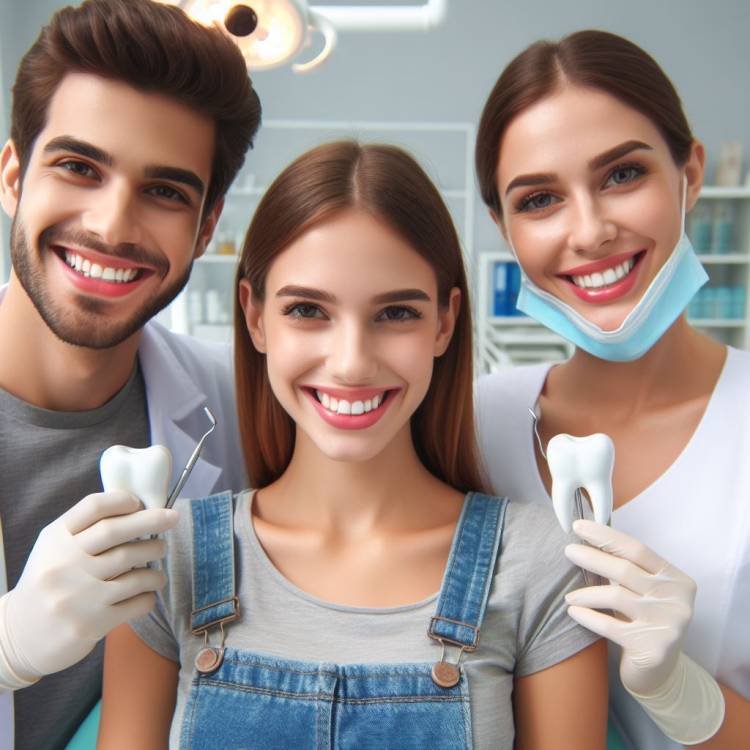Do you ever feel like perfect white smiles are everywhere you look? That’s because the media often shows us images of flawless teeth, which can make us more aware of any discoloration in our own smiles. In the late 1980s, companies started offering products for teeth whitening, both for home use and by professionals. These products have become really popular as more people want whiter, more perfect smiles.
At Pristine Dental Clinic, we understand the importance of a bright smile. We offer a range of teeth whitening treatments to help you achieve the perfect smile you’ve always wanted.
There are different ways to whiten teeth, and each method works in its own way. The success of these methods depends on what’s causing the discoloration. Tooth discoloration can be split into two main types: intrinsic and extrinsic staining. Intrinsic staining, also called internal staining, can happen because of things like genetics, getting older (which can make the enamel thinner and show the yellower dentin underneath), certain antibiotics, too much fluoride, or developmental disorders.
Some dental treatments can also cause staining after the tooth has come in. Extrinsic staining, or external staining, is mostly caused by things in our environment, like smoking, pigments in food and drinks, antibiotics, and metals like iron or copper. These coloured compounds can stick to the outside of the tooth or to a layer called the dental pellicle, causing stains.

Let’s Understand Tooth Whitening Chemistry
How does this Magic Potion Work?
Have you ever wondered how tooth whitening works? It’s all about using special chemicals to lighten the colour of your teeth. This can be done by physically removing stains or by a chemical reaction that lightens the tooth colour. This chemical reaction is called bleaching, where the chromogens (the compounds that give stains their colour) are chemically degraded.
The main ingredient in most whitening products is hydrogen peroxide (H2O2), which is delivered as either hydrogen peroxide itself or as carbamide peroxide. Carbamide peroxide is a stable compound that breaks down into hydrogen peroxide when it comes into contact with water. Since hydrogen peroxide is the key player in tooth whitening, let’s focus on its chemistry.
Tooth stains can be either inside the tooth (intrinsic) or on the surface (extrinsic). Chromogens, which give these stains their colour, fall into two categories: large organic compounds with double bonds in their structure and metal-containing compounds.
Hydrogen peroxide works by oxidising the double bonds in the organic chromogens, turning them into lighter-coloured compounds. However, bleaching metal-containing compounds is more challenging, and for these cases, options like veneers, bonding, or crowns may be more suitable.
There are different types of whitening products available, each designed to target specific types of stains. These include cleansers, which contain detergents and abrasives to remove surface stains; bleaches, which react with chromogens to lighten colour; and products that combine cleansing and bleaching properties.
For more severe or complex stains, it’s best to seek professional treatment, while over-the-counter products are suitable for milder cases. The time needed for whitening depends on the concentration of the bleaching compound and the exposure time. The whitening effect is usually around 1 to 2 shades for cleansers and over-the-counter gels, and more for professionally applied products.
Understanding the chemistry behind tooth whitening can help you choose the right treatment for your needs, leading to a brighter, more confident smile!
(Copywrite this for a section about “Understand Whitening Chemistry” in my blog on “Pristine Smiles: Best Teeth Whitening Clinic in Mumbai, 2024”) (use simple words and human like language as my readers do not have any prior knowledge about this topic)
Types of Teeth Whitening Treatments
Looking to brighten your smile? There are several types of teeth whitening treatments available, each with its method and benefits.
Whitening Toothpaste
These toothpastes contain more abrasives and detergents than regular ones, helping to remove tough stains. While they don’t contain bleach, some may have low concentrations of carbamide peroxide or hydrogen peroxide to lighten tooth colour by about one or two shades.
OTC Whitening Strips and Gels
Whitening strips are thin plastic strips with peroxide gel that you apply to the teeth’s surface. They are used twice daily for about 30 minutes for 14 days. These can lighten teeth by 1 or 2 shades. Whitening gels, applied directly to the teeth, can also lighten teeth by 1 or 2 shades with twice daily use for 14 days.
Whitening Rinses
These rinses contain oxygen sources like hydrogen peroxide to react with stains. You use them twice a day, rinsing for 60 seconds each time. It can take up to 3 months to see a 1 or 2 shade improvement in tooth colour.
Tray-Based Teeth Whiteners
Available both professionally and over-the-counter, these involve using a fitted tray containing carbamide peroxide-bleaching gel. You wear the tray for 2 to 4 hours a day or overnight. Whitening is noticeable in a few days, lightening the teeth by 1 or 2 shades.
In-Office Whitening
This method delivers higher concentrations of peroxide than OTC products, allowing for quicker results. Protective measures are taken to shield gums. Some systems use heat or intense blue light to speed up the chemical reactions. Results are visible after one 30- to 60-minute treatment, with more dramatic results possible with multiple applications.
Risks Associated with Tooth Whitening
When considering tooth whitening, it’s important to be aware of potential risks. While these are generally mild and temporary, it’s still important to understand them:
Increased Tooth Sensitivity: This is a common side effect, with the degree of sensitivity related to the concentration of the bleaching agent and the duration of treatment. Sensitivity can occur during treatment and may last several days.
Mild Gingival Irritation: Some people may experience irritation of the gums, which usually begins within a day of treatment and can also last several days.
Tooth Erosion and Mineral Degradation: Studies have shown potential risks of tooth erosion and mineral degradation from whitening treatments, particularly with aggressive regimens. This can increase susceptibility to demineralization and pulpal damage.
Temporary Whitening: Aggressive treatments can dehydrate and demineralize the tooth, making it temporarily appear whiter. However, this can damage the tooth and is not a desirable outcome.
Individual Tooth Response: The whitening endpoint can vary depending on the tooth itself, and not all teeth will respond the same way to treatment.
While these risks exist, they are generally low when whitening is done under the supervision of a dental professional. It’s always best to consult with your dentist before starting any whitening treatment to ensure it’s safe and suitable for you.

What Does New Research Say?
Effects of Aggressive Bleaching: Aggressive bleaching can lead to increased tooth sensitivity, changes in tooth microstructure, and even affect the stability of dental restorations. It can chemically react with composite restorations, glass ionomer cements, sealants, and ceramic crowns, reducing their stability.
Surface Softening of Restorations: In a study, various tooth-colored restorative materials were exposed to hydrogen peroxide gel. The materials showed surface softening, particularly at higher temperatures, but no substance loss was observed. However, these conditions did not include subsequent abrasion, which could lead to material loss in real-life situations.
Color Change and Translucency of Resin Composites: Home-based bleaching treatments with carbamide peroxide or hydrogen peroxide caused significant color change in resin composites, but no change in translucency. This indicates that the color change was limited to the surface of the composites.
In-Office Bleaching and Tooth Sensitivity: A clinical trial found that in-office bleaching with a 35% hydrogen peroxide product caused tooth sensitivity in all cases, especially for teeth with restorations. While effective, this method may lead to higher levels of discomfort, particularly in certain teeth.
Enamel Erosion and Demineralization: Aggressive bleaching treatments can change the surface integrity and microstructure of enamel, making it more susceptible to demineralization. Studies suggest that peroxide in bleaching gels can penetrate deeper into enamel, altering its susceptibility to demineralization.
Persistence of Whitening Treatments: Studies have shown that while whitening treatments can be effective, the results may not be permanent. Factors such as exposure to staining agents like coffee or tobacco can affect the longevity of the treatment.
Efficacy of Light Activation: The efficacy of light activation in tooth bleaching is still debated. Some studies suggest that light activation has no significant effect on bleaching outcomes, while others find it can increase tooth sensitivity without improving bleaching results.
Clinical Recommendations: Dentists should inform patients about the expected outcomes and potential risks of different bleaching procedures. Evidence-based choices, including a combination of in-office and home bleaching, can be effective in achieving desired results while minimising discomfort.
My Final Thought
At Pristine Dental Clinic, we prioritise your dental health and well-being by focusing on important factors that ensure your smile stays bright and healthy. Our team of experienced professionals takes the time to understand your unique needs and provide personalised care. We stay updated with the latest research and technology to offer you the best dental solutions.
When you visit Pristine Dental Clinic, you can expect us to recommend the best dental care practices tailored to your specific needs. Whether it’s regular check-ups, professional teeth whitening, or dental restoration, we will guide you on the path to a healthy and beautiful smile.
Trust Pristine Dental Clinic to take care of your dental needs and suggest what’s best for you. Your smile is our priority!
Additional Insights from Whitening Literature:
- Light Activation: Studies show that light activation during bleaching doesn’t offer any significant benefits in terms of whitening results, treatment persistence, or reducing tooth sensitivity.
- Home-Based vs. In-Office Bleaching: Home-based bleaching, when done according to the manufacturer’s instructions, tends to result in less tooth sensitivity compared to in-office bleaching.
- Optimal Whitening Regimen: For long-lasting whitening effects, it’s recommended to start with an in-office treatment followed by monthly home-based touch-ups using over-the-counter products.
- Aggressive Bleaching Risks: High concentrations of hydrogen peroxide in office-based bleaching can soften enamel, increase surface roughness, and make teeth more susceptible to demineralization, based on lab studies.
- Effects on Dental Restorations: Even with home-based over-the-counter systems, dental restorations can undergo unacceptable color changes.
- Tooth Sensitivity: In-office bleaching with a 35% hydrogen peroxide product caused tooth sensitivity in all cases, with restored teeth being more sensitive and painful.
Summary
When used correctly, hydrogen peroxide and carbamide peroxide-based tooth whitening treatments are safe and effective. However, as with any dental procedure, there are risks involved. It’s important to tailor the whitening approach to each patient’s needs, considering factors like staining type, diet, previous dental work, and oral health.
Patients should be aware of the potential risks and seek professional help if they experience any adverse effects. Supervision by a dental professional can reduce risks and maximize the benefits of tooth bleaching.
FAQs
Yes, teeth whitening is safe when done correctly. It’s important to follow the instructions provided by your dentist or the product manufacturer.
The duration of teeth whitening results varies from person to person. With proper care and maintenance, the effects can last from several months to a year or more.
Some people may experience tooth sensitivity during or after teeth whitening. This is usually temporary and can be managed with desensitizing toothpaste or gels.
Teeth whitening may not change the color of dental restorations like crowns or fillings. It’s best to consult with your dentist to discuss options for matching the color of your natural teeth.
Yes, there are various teeth whitening treatments available, including in-office bleaching, at-home bleaching kits, and over-the-counter whitening toothpaste and strips.
Individuals with sensitive teeth should consult with their dentist before whitening. Your dentist may recommend a gentle whitening approach or products specifically designed for sensitive teeth.
The degree of whitening varies depending on the individual’s teeth and the whitening method used. Most treatments can lighten teeth by several shades.
The most common side effects of teeth whitening are temporary tooth sensitivity and mild gum irritation. These usually resolve after treatment.
It’s generally recommended to wait several months between teeth whitening treatments to prevent damage to the enamel and tooth sensitivity.
Some natural remedies, such as baking soda, activated charcoal, or coconut oil pulling, are believed to whiten teeth. However, their effectiveness and safety are not well-documented, so it’s best to consult with your dentist before trying them.
Pristine Smiles Dental Care Juhu
1, Jayanti Niwas, Opp. Vaishali Hotel, Near Iskcon Temple, Jukarwadi, Juhu, Mumbai, Maharashtra 400049

